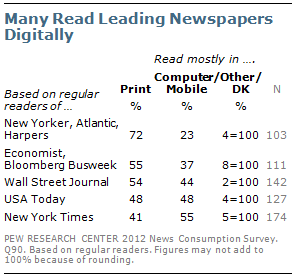[Post by Rex Hammock]
Because Hammock has a long history of publishing print magazines while, simultaneously, serving as creators of digital media delivered to audiences via screens (starting back in the days of CompuServe and laserdiscs), I’m often asked about the future of print magazines – as in: Will print magazines still be around in the future?

Time is ticking away.
These questions typically spike whenever there is news involving closures or layoffs at once-powerful magazines like Time or Newsweek. or when a famous person like a Facebook co-founder sparks a lot of media coverage for buying a magazine like The New Republic.
Here’s my quick answer to the question, “Will print magazines be around in the future?”:
“Yes, but…”
For a much longer version of this answer – a version with predictions covering all types of print magazines – read on…
Okay, you’ve been forewarned: You’re entering a longread zone.
Context and Definitions
Some readers may need a little background before understanding where some of these predictions came from, so consider the next few paragraphs something like the beginning of an episode of a TV drama where the announcer says, “Previously on Homeland…”
First, a clarification. If you’re not familiar with my decade of sharing opinions on this topic on RexBlog.com and other places, please note that I am passionate about and create professionally all sorts of media intended for screens. Even when I say there is a future for ink on paper, don’t confuse me with someone who wants to hold on to the good old days when we’d all gather ’round the fireplace to read the Saturday Evening Post, admiring the Norman Rockwell illustrations and noting to one another how much we enjoyed the tactile quality of print magazines.
The difference between the Magazine Format and the Magazine Business Model
- The Magazine Format: The familiar print publication that is comprised of a certain set of editorial and design conventions (paper trim sizes, a cover, a table of contents, etc.) that are used to produce the recurring periodical that, over the past couple of centuries, we have all agreed to call the magazine. People still love the print magazine format. Sure, you can read the same stuff on a screen … but you can also drink coffee at places other than Starbucks. I could wax on about the unique values of a print magazine, but let’s move on.
- The Magazine Business Model:This model starts with the magazine format and then layers on some financial transactions and traditions (advertising, subscriptions, newsstand sales). The business model assumes the magazine will play a pivotal role in a defined market place that will facilitate buyers and sellers to connect. When all combined, revenues from advertising, subscriptions and newsstand sales should generate more revenues than expenses (also known as “profit”). If revenues come from other sources, the business model starts to become something other than the magazine business model. Also, as you’ll see, I think that’s a very good and important thing to do.
Now, let me repeat that for those who prefer sentences over bullet-points: There are print publications called magazines. And there is a business model that is related to a sub-set of those publications.
The difference between the terms Print Magazine and Screen Magazine

At Hammock, the terms “print magazine” and “magazine” are used interchangeably to describe a publication that is designed for a reader who will experience it on paper. The term “screen magazine” refers to a publication that is designed for a reader who will experience it on a screen.
Nothing in this post refers to a publication designed for print that is digitized (like a PDF of a print magazine, even if it is displayed in an application that lets you pretend to flip pages). We call the designed-for-print-but-ends-up-on-a-screen publications “digitized magazines” and believe they may be good for archival purposes, though not as much for reading or communicating purposes. This is not a criticism of any software, file-format or platform — one can design a screen magazine for any platform — even for something that will end up as a PDF. It means, merely, that we strongly believe there is a way to design magazines for print readers and a way to design a magazine for screen readers. One design doesn’t work for both. In other words, if you ever hear me suggest that a screen magazine should replace a print magazine, I’m not saying it should look like a print magazine. I’m referring to something that’s looks more like qz.com
Trend Prediction #1: The Magazine Business Model is like Wile E. Coyote in mid-air.

Help!
When there are events like the layoffs at Time, the coverage of them typically refer to something that readers are presumed to understand as being “the problems in the magazine industry.” However, what the reporter is actually referring to is a specific subset of the magazine industry called consumer magazines. Furthermore, the “magazine industry” to which the reporters are referring is even a more narrow subset of consumer magazines that are distributed nationally and published by a handful of very large media companies located in New York City and — wait for it — Des Moines, Iowa. This use of the term “magazine industry” is akin to how reporters use the term “music industry” when they are referring to the industry comprised of multinational recording companies.
However, just like in the music industry comparison, consumer magazines comprise only a subset of the entire magazine industry.
My friend, Doc Searls, originally said the following in regard to blogs, but over the years, I’ve adapted it to refer to magazines: “There are magazines that are a business model, and there are magazines that support a business model.”
The print magazine business model I described above — the one that has a magazine as the foundation of a brand and the business generates a profit exclusively from advertising, newsstand and subscription revenue — is dead, kaput, over. Even the executives who run companies that have the magazine business model know it. That’s why they have all dropped the word “magazine” from their company’s names, laid off lots of reporters and are trying desperately to replace them with software developers. They have declared themselves digital media companies and like to use phrases like “multichannel” and “integrated.” Rather than being media and editorial experts, today they describe themselves as if they were marketing agencies, internet startups or designer labels. Perhaps that’s what they should be doing. But that’s not the magazine business model. It bears repeating: That model is dead.
Trend Prediction #2: Print Magazines supporting a business model other than a magazine business model have a more promising future, but only if …
Here’s something you may not know: Most magazines in America never had a magazine business model or strategy. Most magazines are created and published to support another kind of business model.
Think about the magazines you receive in your mail box or that are delivered to your desk. You probably get a magazine from organizations that have a wide variety of business models: the university business model, the professional association business model or the nonprofit service organization business model. More and more, your magazines may come from companies that have an automobile business model or a supermarket business model. Some of the largest circulation magazines in America have lobbying group business models or religious organization business models.
Each of these organizations has different reasons for publishing print magazines that are known to provide a significant return on investment, even when they do not carry advertising or require readers to pay a subscription. Again, these are magazines that support a business model other than the magazine business model.
Hammock’s business includes assisting organizations publish these types of magazines, so I can say with some inside knowledge backed up by proprietary research by clients and others, print magazines supporting other business models are still quite powerful if the content is aligned with the objectives of the business model and serves the needs of the audience. I do not mean that the magazine should be a “house organ” or some form of propaganda — I believe such magazines fail. I mean the magazine must align with the reason the reader has a relationship with the organization, and must serve a unique role in starting or extending a relationship that is beneficial to both the reader and the organization.
My List of General predictions About The Future of Print Magazines
I’ve found that doubts about the future of print magazines typically occur when the people who say, “I love reading the newspaper in print” realize they spend more time keeping up with news via a screen than they ever have with print. Or, more noticeably, when they discover the practicality of reading books on a screen. One day they start thinking about how their personal reading habits have changed, and they begin to wonder what’s going to happen to the daily newspaper or print magazines they never look at anymore.
The personal experience these people are having with digital and print media is a good indication of what the “beginning” of the future of media is.
While I have pondered the following predictions over a period of two decades, they are, more or less, the same ones you could hammer out in an afternoon if you use a computer and mobile devices throughout the day. (Remember: Unless I use the term “screen” before it, the word magazine refers to print magazines. In some cases, I’ll go ahead and add the term print just to make my point.)
- The era of the weekly mass-market general news magazine business model has ended. I believe everyone except Time magazine has received the memo. This is especially ironic considering that Wile E. Coyote and Time Inc. executives work for the same company. Coyote could have sent them an inner-office memo based on his experience in gravity denial. Oh, well.
- The era of the less-than-monthly mass-market general business news magazine business model will extend longer into the future as they enjoy some unique economic advantages and incentives:
- Subscriptions are typically paid by the reader’s employer
- The person or organization subscribing can deduct the associated costs as a business expense. (Warning: Don’t try that at home with your subscription to People, even if you blog all the time about the Kardashians.)
- A business magazine adds a power-statement to the coffee table of a corporate executive’s office
- CEOs love seeing ads for their company printed on nice, glossy paper
There are two business magazines that I think will be around in print longer than others: The Economist and Bloomberg’s BusinessWeek. The Economist, because Americans are enamored with things that look stodgy but are secretly witty – and the magazine is counter-intuitively hip. The second magazine, because it probably has a reason for being beyond the magazine business model discussed previously. I’m not sure what that is, but when your owner has $25 billion, there’s always the wildcard reason that also drives such individuals to purchase NFL teams. And yes, this means I predict Forbes and Fortune will one day not exist on paper. They both have powerful brands and franchises that will live on via screens forever, however. And the annual Fortune and Forbes listings of big companies and rich individuals will continue to appear on newsstands.
- The future of print-based trade magazines is a mixed bag and, frankly, depends on how smart and resourceful the publisher is. The smart business-to-business media companies had already figured out what internet startups labeled the freemium business model. B-to-B media called it “controlled circulation” because they thought “free” sounded cheap. Internet startups, on the other hand, convinced venture capitalists to understand that free can sometimes mean velocity and scalability. The savvy business media companies make money by giving away magazines — using it as a vehicle to become their industry’s primary marketplace for networking and commerce. So they’ll be around for a long time. And their print magazine will stay around, as it looks good on the coffee table of business executives in that industry.
 Print magazines will continue to have less and less “news” – and more and more “context.” Magazines have never been great at breaking news. They’re better at aggregating, investigating, analyzing and interpreting the news – showcasing writing, photography and illustration that provide background, context and understanding. Combine that with our growing belief that, if it’s news, we should be reading it on a screen. You don’t need a calculator to do the simple math from trends revealed in Pew’s annual survey of “news consumption.” It is worth noting the comparison of “screen vs. print” readership the further you get away from news. (See the chart at right.)
Print magazines will continue to have less and less “news” – and more and more “context.” Magazines have never been great at breaking news. They’re better at aggregating, investigating, analyzing and interpreting the news – showcasing writing, photography and illustration that provide background, context and understanding. Combine that with our growing belief that, if it’s news, we should be reading it on a screen. You don’t need a calculator to do the simple math from trends revealed in Pew’s annual survey of “news consumption.” It is worth noting the comparison of “screen vs. print” readership the further you get away from news. (See the chart at right.)- University alumni magazines (and association magazines, major non-profits, and similar organizations) will continue for the foreseeable future. Why? Because there is measurable evidence that contributions and membership renewals are directly tied to an organization’s magazine (down to the number of days between when the magazine is mailed and when the checks roll in). It’s hard to argue with facts, even if you want to believe people would prefer screen-reading their alumni publication.
- The company-published employee print magazine is endangered, (unfortunately). I think a few large and smart companies will continue to use print for such magazines. Print tells big stories in a way that you can’t convey on screens. But due to costs, screens are where employee magazines are heading (and Hammock is heading there with them). As this post is focused on print, I’ll save my predictions for employee screen magazines for a later post. Spoiler: There will be lots of employee magazines published for screens from companies who never had such a magazine in print. Many won’t be good. A few will be spectacular.
 Customer magazines (magazines published by companies for their customers) are going to be around a long time. The best are those from companies run by marketing-savvy executives like those at Restoration Hardware. Its RH Sourcebook is a unique medium that feeds a passion (design inspiration), serves a function (sourcing merchandise) and builds the brand all while unapologetically selling stuff. And did I mention that it looks good enough to be displayed on coffee tables? In other words, it’s 900+ pages, spread over three magazines, that all support a business model other than the magazine business model. Didn’t receive the print version? There’s an app for that or you can view an online digitized version. And the best part about the over-the-top mailing: it worked.(Note: I limited my praise to their marketing savvy.)
Customer magazines (magazines published by companies for their customers) are going to be around a long time. The best are those from companies run by marketing-savvy executives like those at Restoration Hardware. Its RH Sourcebook is a unique medium that feeds a passion (design inspiration), serves a function (sourcing merchandise) and builds the brand all while unapologetically selling stuff. And did I mention that it looks good enough to be displayed on coffee tables? In other words, it’s 900+ pages, spread over three magazines, that all support a business model other than the magazine business model. Didn’t receive the print version? There’s an app for that or you can view an online digitized version. And the best part about the over-the-top mailing: it worked.(Note: I limited my praise to their marketing savvy.)- Magazines that serve an audience niche that is intensely passionate about something will survive. Such magazines are focused on parenting, celebrities, fly fishing, eating great food, losing weight, running, bicycling, etc. If you are passionate about something such as fashion or design or woodworking, you can’t get enough of magazines (and websites and blogs) on the topic. Tightly focused enthusiast print magazines — with an engaged audience valuable to a significant group of advertisers underserved by other media options — aren’t going away anytime soon. These print magazines still work, even when they’re just focused on the magazine business model. But they’re pretty hard to make work. If you’ve heard the expression,”“belling the cat,” it’s similar to execution phase of creating a magazine like that.
- As the “Maker” movement and culture gathers steam, short-run independent magazines will be the fastest-growing (and most exciting) segment of the magazine world. For almost a decade, I’ve been blogging about Derek Powazek’s early, visionary efforts to display the opportunity that will emerge when the technology and economics of on-demand magazine printing line up. After many years of corresponding online with Derek, it didn’t surprise me that our first face-to-face meeting would be at such an appropriate event: 2012’s XOXO Festival in Portland, Oregon, which turned out to be the first major gathering of a cross-pollenating collection of various tribes of “Makers.” Derek agrees with me that just like the makers who are changing indie music, film, videogames, arts, crafts, clothes, auto parts, etc., the magazine world will be changed by the creators of short-run print magazines. These magazine makers are going to be at the center of a sustainable business model for certain creative and motivated individuals and groups who will develop a community, audience and fan-base centered on shared passions. Unlike hobbyist “fan-zines,” magazine maker businesses will be similar to successful indie music companies: They will produce great products (or, what is considered great to group of individuals), and some will thrive — but no one’s going to get rich. (Well, except for a rare few who will be discovered by the man, cash out, lose all their cred and end up the subject of a sad feature story appearing in a short-run magazine.)
- Magazines that remind us – and others – of who we are, or who we aspire to be, will be around forever. The notion that print magazines will die because people can read the same content on a screen can be dispelled by the millions of subscribers to a handful of magazines that have never been read, but are perpetually renewed. Think about it. Has anyone actually read the New Yorker? So why do they buy it, other than for the cartoons? Why do such people (and we know who my name is) have a stack of them sitting on the floor next to their desk while they are writing this post? And why is Gardens & Guns a massive hit in my part of the country? And why do rows of back issues of National Geographic line millions of book shelves? Is it because some people read them? Well, hmmm. Based on years of research consisting primarily of me looking at people’s coffee tables, my theory is that the magazines we purchase and display — and one day hope we’ll get around to reading — serve as an expression of who we are, or perhaps, who we aspire to be. They’re not just titles we believe will impress others – but they’re there as a reminder to ourselves. Perhaps they’re status symbols, though the least inexpensive status symbols one can purchase. If you want to know how people want others to view them, look at the magazines they display on their living room coffee tables or in their offices. If you want to know who they really are, look at the magazines they have in their workshops, kitchens or the ones they dropped on the floor next to their bed as they fell asleep.
- As long as there are coffee tables, there will be magazines: I’ll admit: This is just another way of expressing the idea in the previous prediction. But I’ve been saying it for 15 years, and I couldn’t help myself.
![]() One final prediction: I forgot to place a time-horizon on these predictions. I predict print magazines will be around for the long run. And by that, I’m referring to the time-horizon made popular by the economist John Maynard Keynes when he observed, “In the long-run, we are all dead.”
One final prediction: I forgot to place a time-horizon on these predictions. I predict print magazines will be around for the long run. And by that, I’m referring to the time-horizon made popular by the economist John Maynard Keynes when he observed, “In the long-run, we are all dead.”



